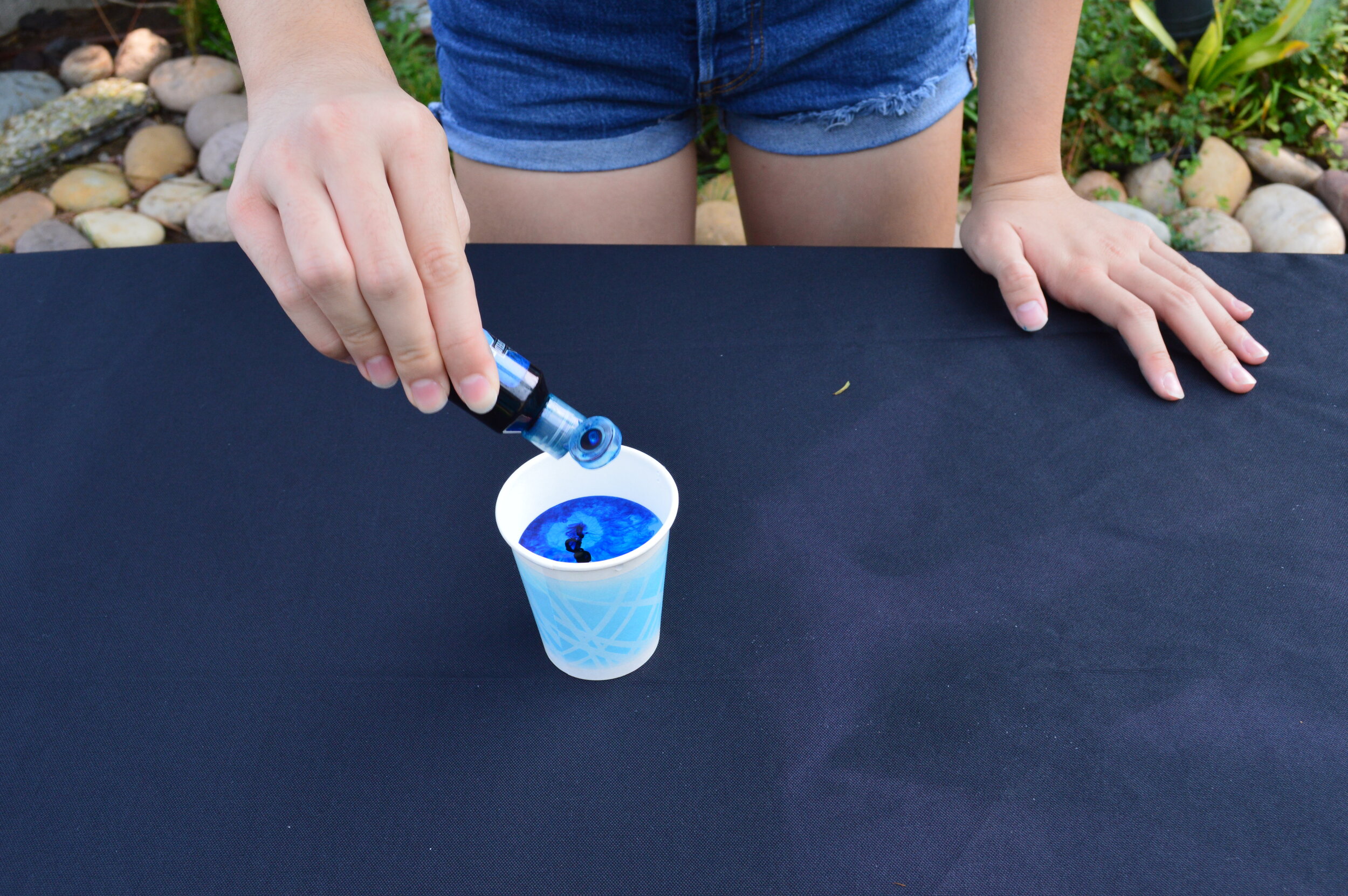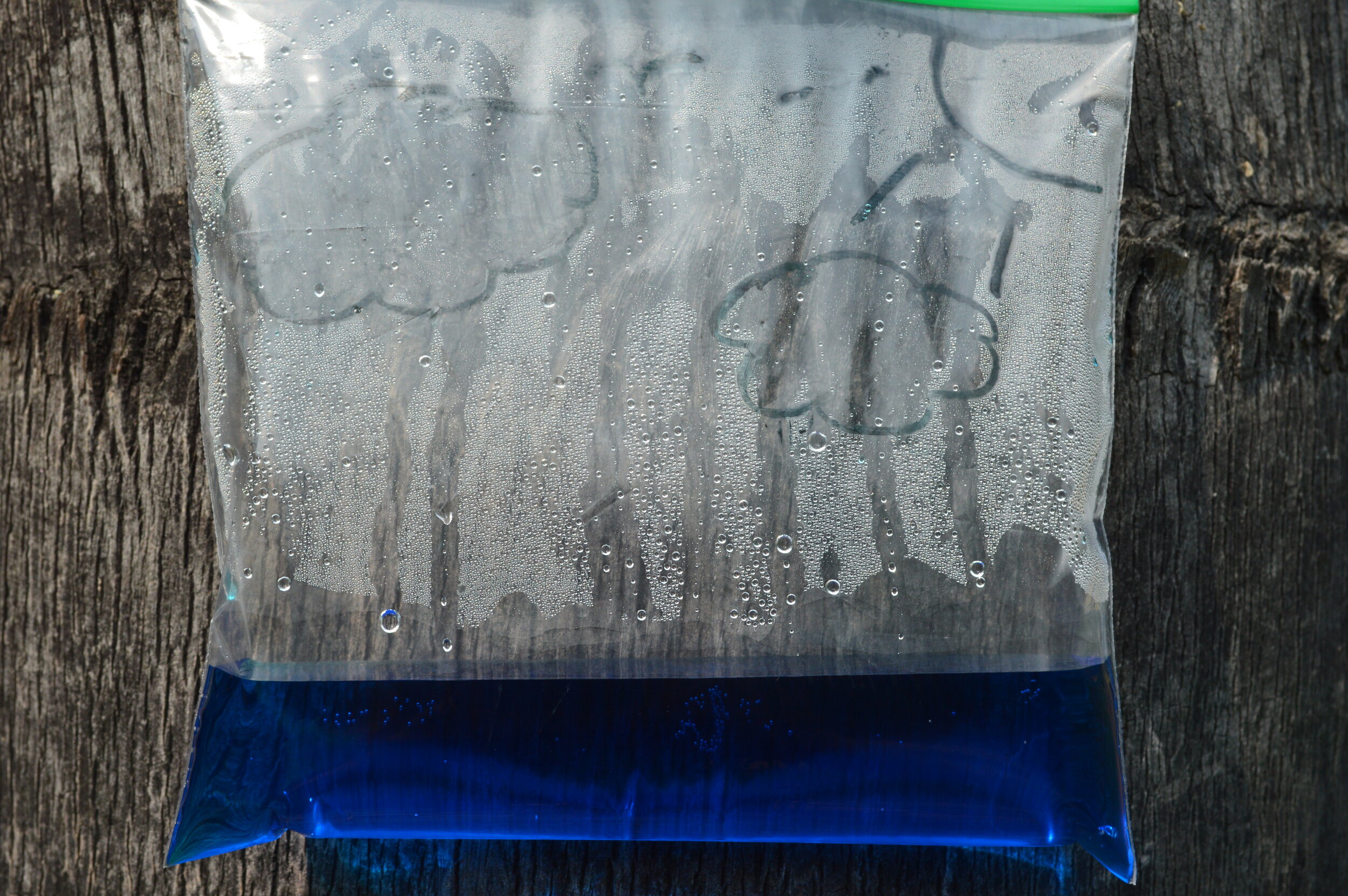Water Cycle in a Bag
Become a child of Poseidon as you control water to create your very own rain. Using only household items you can easily demonstrate the water cycle!
Materials
Plastic zip lock bag (sandwich size)
A Black Sharpie or marker
About 1/2 cup of water
Clear tape
Blue food coloring
Spoon
Procedure
Gather your materials.
Step 1
Decorate your bag. The top half of the bag represents the sky, so draw what you see in the sky! (examples: clouds, sun, birds)
Step 2
Add a few drops of blue food coloring to the water and mix well. This will make the water easier to see!
Step 3
Fill up the bag with water until it is an inch from the bottom.
Step 4
Close the bag nice and tight so that no water or air can escape!
Step 5
Hang up the bag using tape to a place that gets a lot of direct sunlight. This could be a window, a tree, a chair, etc. Tape it well, so it doesn’t fall!
Step 6
Now all you have to do is wait and observe! You will need a lot of patience as it may take from a few hours to half a day to see any changes depending on the amount of sun it receives.
Science Explanation
Kindergarten - 2nd Grade . . .
- Have you ever played in puddles on a rainy day? You may see that a few hours after the rain has stopped, the puddles are smaller or all gone! Do you know why this happens?
- This is because the sunlight hits the water in the puddles and turns the water into a gas. It is like when you eat candy and get a lot of energy, maybe jumping around and running. The same thing happens to the water when it gets energy from the sun! The water particles (tiny, invisible pieces of water) jump around and move apart from each other turning them into a gas! Gas is super light, so it goes up into the air and makes clouds! In the clouds, the particles stick together and turn back into a liquid. Water as a liquid is too heavy to stay in the sky, so it falls back down as rain!
- It all starts with water on the Earth such as oceans, lakes, or puddles! What part of your activity do you think that is? (answer: water at the bottom of the bag). When the water particles go up into the sky and form clouds, it is shown in the activity when the sides of the bag look misty or cloudy! When the rain falls down, this is shown in your bag when there are small water drops sliding down the side of the bag!
- Do you remember the last time it rained near you? Was it a few days ago, a week ago, a month ago? K-ESS2-1
- This activity needs a lot of sun. When do you think is the best time to do this? During the day or night? (answer: day) What season would be best (Fall, Summer, Spring, Winter)? (answer: Summer) 1-ESS1-2
- Chikola's Cosmic Challenge: Let it rain, let it pour, you found what you are looking for! Submit the four-letter word for liquid water that falls from the sky to get your points!
3rd Grade - 5th Grade . . .
- There are four main parts of the Water Cycle! These are evaporation, condensation, precipitation, and collection. You can’t see much of this process because the water molecules are invisible in certain portions of the process. 5-PS1-1
- The first part of the cycle is powered by the sun! When water on Earth such as lakes, rivers, or oceans are hit by the sunlight, the sun transfers energy to the water. This makes the water molecules move around more and get farther apart from each other turning into water vapor (a fancy word for water in gas form!). The water vapor is really light and goes up into the sky. This entire process is called evaporation! 4-PS3-2
- Next is condensation! Do you know what the word condense means? It just means to get really close together. This is what happens in the sky! The water molecules in the water vapor get super close together and you can see this through the making of clouds. When the water molecules get closer, it turns back into a liquid and becomes too heavy for the cloud to hold. This leads to the next step...
- Precipitation! This is really just a fancy word for when it rains or snows. Why do you think sometimes it rains and sometimes it snows? (answer: it depends on how cold it is; if it is very cold, the water molecules freeze and it snows, if it is less cold it rains)
- The last stage is collection! This is when all of the rain or melted snow goes into rivers and streams and heads back to larger bodies of water(oceans and lakes), to start the process all over again.
- In this activity, we modeled the entire water cycle but in a single bag! What do you think the water at the bottom of the bag represents? (answer: water on earth) What do you think condensation looks like in the bag? (answer: mist or cloudiness on the sides of the bag) What do you think precipitation looks like in the bag? (answer: water streaks on the side of the bag) What do you think collection looks like in the bag? (answer: water droplets goes to the bottom of the bag with the rest of the water)
- Why do you think the water evaporating in the bag stays in the bag and doesn’t go up into the sky? (answer: the bag was airtight, so no water vapor can escape)
Math Extensions
Kindergarten . . .
- Count the number of drops on the side of the bag!
- CCSS.MATH.CONTENT.K.CC.A.1
Written by Allyson Liu Inspired by: Mobile Ed







